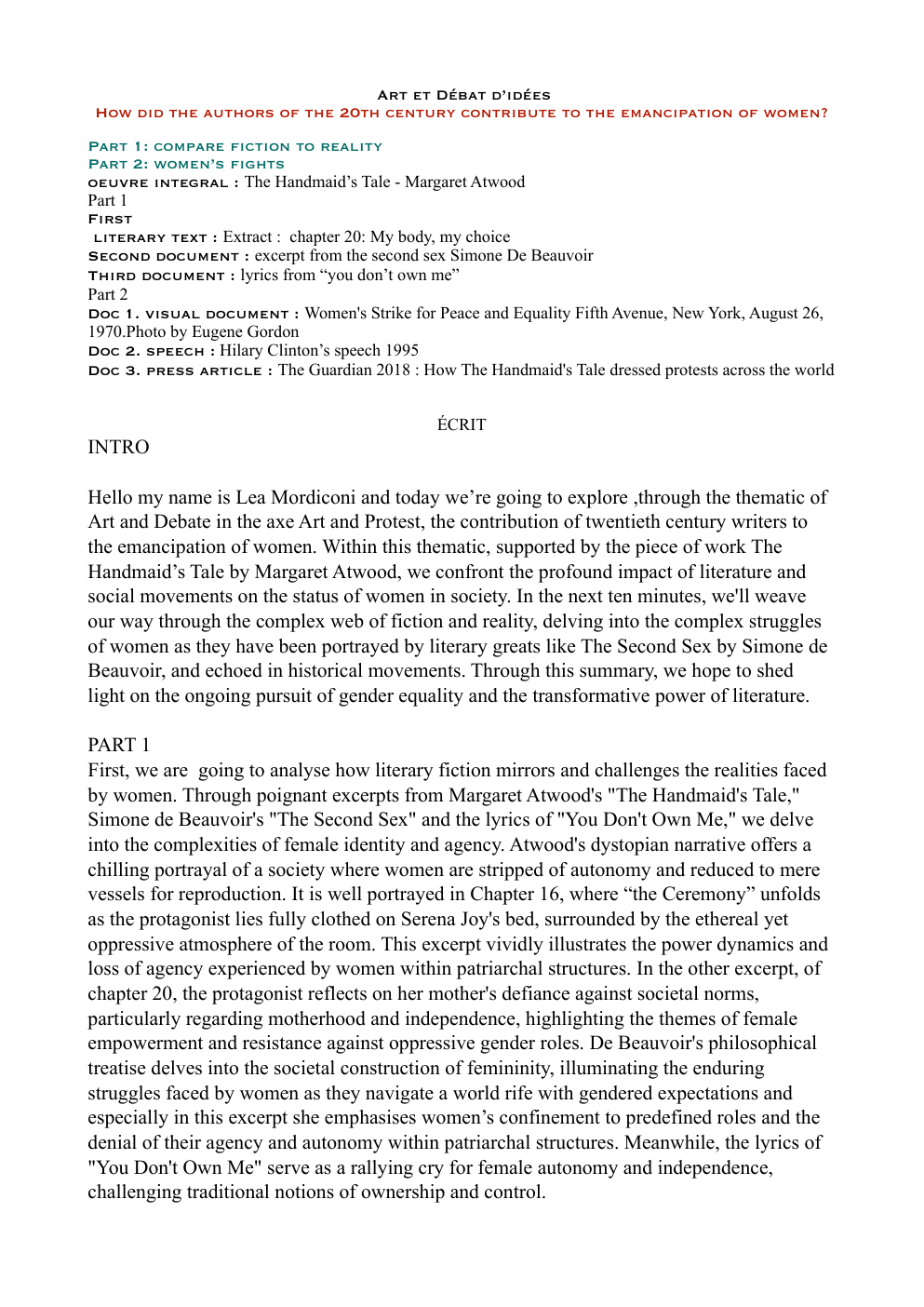Oral de spe anglais Art et Débat d’idées How did the authors of the 20th century contribute to the emancipation of women?
Publié le 26/05/2024
Extrait du document
«
Art et Débat d’idées
How did the authors of the 20th century contribute to the emancipation of women?
Part 1: compare fiction to reality
Part 2: women’s fights
oeuvre integral : The Handmaid’s Tale - Margaret Atwood
Part 1
First
literary text : Extract : chapter 20: My body, my choice
Second document : excerpt from the second sex Simone De Beauvoir
Third document : lyrics from “you don’t own me”
Part 2
Doc 1.
visual document : Women's Strike for Peace and Equality Fifth Avenue, New York, August 26,
1970.Photo by Eugene Gordon
Doc 2.
speech : Hilary Clinton’s speech 1995
Doc 3.
press article : The Guardian 2018 : How The Handmaid's Tale dressed protests across the world
ÉCRIT
INTRO
Hello my name is Lea Mordiconi and today we’re going to explore ,through the thematic of
Art and Debate in the axe Art and Protest, the contribution of twentieth century writers to
the emancipation of women.
Within this thematic, supported by the piece of work The
Handmaid’s Tale by Margaret Atwood, we confront the profound impact of literature and
social movements on the status of women in society.
In the next ten minutes, we'll weave
our way through the complex web of fiction and reality, delving into the complex struggles
of women as they have been portrayed by literary greats like The Second Sex by Simone de
Beauvoir, and echoed in historical movements.
Through this summary, we hope to shed
light on the ongoing pursuit of gender equality and the transformative power of literature.
PART 1
First, we are going to analyse how literary fiction mirrors and challenges the realities faced
by women.
Through poignant excerpts from Margaret Atwood's "The Handmaid's Tale,"
Simone de Beauvoir's "The Second Sex" and the lyrics of "You Don't Own Me," we delve
into the complexities of female identity and agency.
Atwood's dystopian narrative offers a
chilling portrayal of a society where women are stripped of autonomy and reduced to mere
vessels for reproduction.
It is well portrayed in Chapter 16, where “the Ceremony” unfolds
as the protagonist lies fully clothed on Serena Joy's bed, surrounded by the ethereal yet
oppressive atmosphere of the room.
This excerpt vividly illustrates the power dynamics and
loss of agency experienced by women within patriarchal structures.
In the other excerpt, of
chapter 20, the protagonist reflects on her mother's defiance against societal norms,
particularly regarding motherhood and independence, highlighting the themes of female
empowerment and resistance against oppressive gender roles.
De Beauvoir's philosophical
treatise delves into the societal construction of femininity, illuminating the enduring
struggles faced by women as they navigate a world rife with gendered expectations and
especially....
»
↓↓↓ APERÇU DU DOCUMENT ↓↓↓
Liens utiles
- Walter Gropius Walter Gropius (1883-1969), German American architect and educator, who founded the Bauhaus, a German art school that became a seminal force in architecture and applied art during the first half of the 20th century.
- Henri Matisse Henri Matisse (1869-1954), French artist, leader of the fauve group (see Fauvism), regarded as one of the great formative figures in 20th-century art, a master of the use of color and form to convey emotional expression.
- Art Nouveau I INTRODUCTION Detail of Art Nouveau Decoration This detail of a door decoration from a building constructed in the early 20th century in Milan, Italy, illustrates the stylistic themes associated with art nouveau.
- Modern Art I INTRODUCTION American Gothic American Gothic was painted by the 20th-century American artist Grant Wood in 1930.
- Oral d'anglais : The idea of progress



















